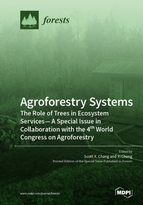Agroforestry Systems: The Role of Trees in Ecosystem Services—A Special Issue in Collaboration with the 4th World Congress on Agroforestry
A special issue of Forests (ISSN 1999-4907). This special issue belongs to the section "Forest Ecology and Management".
Deadline for manuscript submissions: closed (8 October 2019) | Viewed by 57815
Special Issue Editors
Interests: plant and soil interaction; the effects of global change factors on soil N availability in terrestrial ecosystems; soil gross N transformation processes and their functional microorganisms; application of 15N tracing technique in forest, grassland and agroecosystem research; methods to enhance soil NO3-immobilization: The linkage between soil NO3- immobilization and organic matter quality; mitigation of N2O and NO emissions
Interests: forest soils; soil nutrient cycling and plant nutrition and the application of soil science in land reclamation, agriculture, forestry and rangeland management
Special Issues, Collections and Topics in MDPI journals
Special Issue Information
Dear Colleagues,
Planting trees in the agricultural landscape in the form of establishing agroforestry systems has a significant role to play in potentially improving ecosystem services, such as increased biodiversity, reduced soil erosion, increased soil carbon storage, improved food security and nutrition, and reduced greenhouse gas emissions. While the role of trees in agroforestry systems in improving ecosystem services has been researched, studies in new systems/regions and new agroforestry system designs are still emerging. This Special Issue will include selected papers presented at the 4th World Congress on Agroforestry, Montpellier, France 20-22 May 2019, and other volunteer papers. The scope of articles will include all aspects of agroforestry systems.
Prof. Scott X. Chang
Dr. Yi Cheng
Guest Editors
Manuscript Submission Information
Manuscripts should be submitted online at www.mdpi.com by registering and logging in to this website. Once you are registered, click here to go to the submission form. Manuscripts can be submitted until the deadline. All submissions that pass pre-check are peer-reviewed. Accepted papers will be published continuously in the journal (as soon as accepted) and will be listed together on the special issue website. Research articles, review articles as well as short communications are invited. For planned papers, a title and short abstract (about 100 words) can be sent to the Editorial Office for announcement on this website.
Submitted manuscripts should not have been published previously, nor be under consideration for publication elsewhere (except conference proceedings papers). All manuscripts are thoroughly refereed through a single-blind peer-review process. A guide for authors and other relevant information for submission of manuscripts is available on the Instructions for Authors page. Forests is an international peer-reviewed open access monthly journal published by MDPI.
Please visit the Instructions for Authors page before submitting a manuscript. The Article Processing Charge (APC) for publication in this open access journal is 2600 CHF (Swiss Francs). Submitted papers should be well formatted and use good English. Authors may use MDPI's English editing service prior to publication or during author revisions.
Keywords
- adoption of agroforestry practices
- agroforestry policies
- agroforestry system
- air and water quality
- biodiversity conservation
- carbon sequestration
- climate change
- ecosystem services
- food security and nutrition
- greenhouse gas emission
- mitigation
- modeling
- resource use efficiency
- restoration of degraded land
- soil enrichment
- soil conservation







